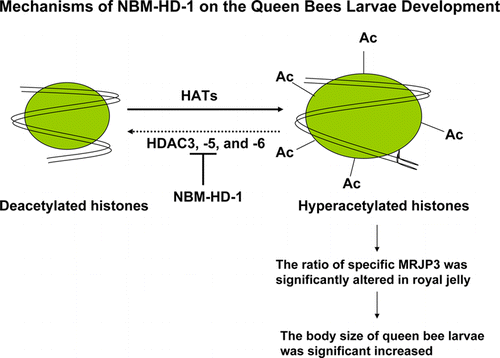Enhanced royal jelly produces jumbo queen bee larvae

Scientists have discovered a way to make worker bees produce an enhanced version of royal jelly (RJ) – the super-nutritious substance that dictates whether larvae become workers or queens, and that is also renowned as a health supplement for people. Their study, which found that the super RJ that makes queen bee larvae grow 2-3 times larger than normal, appears in ACS' Journal of Agricultural and Food Chemistry.
Chia-Nan Chen and colleagues explain that royal jelly is a thick liquid made up of proteins, sugars and fats that is secreted by glands in the throats and jaws of worker bees and fed to larvae. Workers feed all bee larvae RJ for the first three days of their lives, but only the queen gets it throughout life, growing larger and living up to 15 times longer than other bees. The scientists treated worker bees with drugs called histone deacetylase inhibitors (HDACis) to see whether they could enhance the larvae's growth.
They found that worker bees given HDACis produced a fortified royal jelly that made the queen bee larvae grow to be 2-3 times larger than larvae fed standard royal jelly. A couple HDACis have already been approved for treating certain forms of cancer. The scientists noted that this is the first study showing that the composition of RJ can be modified in a way that changes the body size of queen bees during development.
More information:
Growth Stimulating Effect on Queen Bee Larvae of Histone Deacetylase Inhibitors, J. Agric. Food Chem., 2012, 60 (24), pp 6139–6149
DOI: 10.1021/jf300815b
Abstract
Royal jelly (RJ) is a widely used natural food. It is also a major source of nutrition for queen bees and plays a key role in their development. RJ is secreted from the hypopharyngeal and mandibular glands of young adult worker bees. The regulation of gene expression in these two glands may influence the development of queen bees by affecting the content of RJ. This study investigated the epigenetic effects in these two glands in young adult worker bees treated with histone deacetylase inhibitors (HDACis), a U.S. Food and Drug Administration-approved drug, suberoylanilide hydroxamic acid (SAHA), and NBM-HD-1, a novel compound synthesized in this laboratory. Western blot analyses indicated that the levels of acetyl-histone 3 and p21 protein expression in MCF-7 cells increased markedly after treatment with NBM-HD-1. The data proved that NBM-HD-1 was a novel and potent HDACi. Furthermore, a method of affecting epigenetic regulation of the mrjp family gene in the hypopharyngeal and mandibular glands of young adult worker bees was developed by feeding young adult worker bees HDACi. Epigenetic regulation produced several important biological effects. A marked change in the protein composition of the RJ secreted from these treated bees was found. Only the ratio of specific major royal jelly protein 3 (MRJP3) was significantly altered in the treated bees versus the untreated controls. Other MRJP family proteins did not change. This alteration in the ratio of royal jelly proteins resulted in a significant increase in the body size of queen bee larvae. The data seem to suggest that HDACis may play an important role in the epigenetic regulation of the hypopharyngeal and mandibular glands of young adult worker bees. They appear to change mrjp3 gene expression and alter the ratio of MRJP3 protein in RJ. This study presents the first evidence that HDACis are capable of regulating the ratio of MRJP3 proteins in RJ, which has the potential to change the body size of queen bees during their development.
Journal information: Journal of Agricultural and Food Chemistry
Provided by American Chemical Society




















